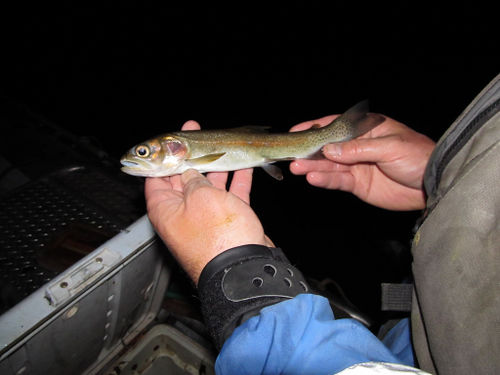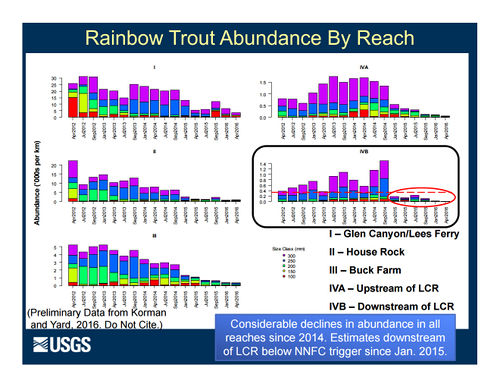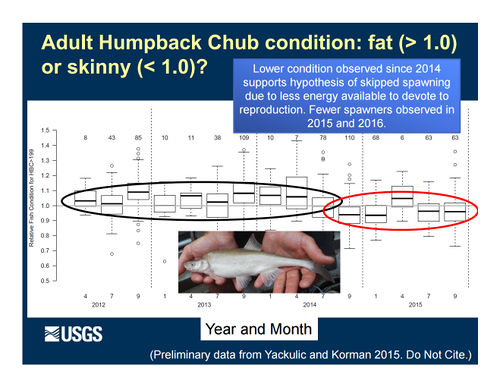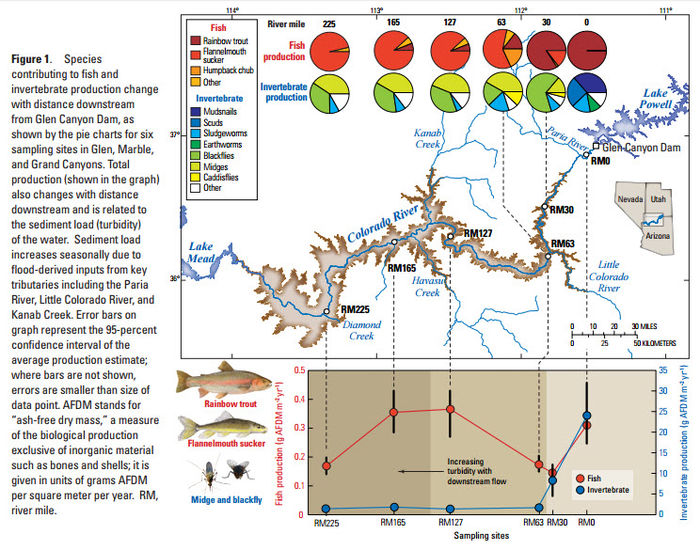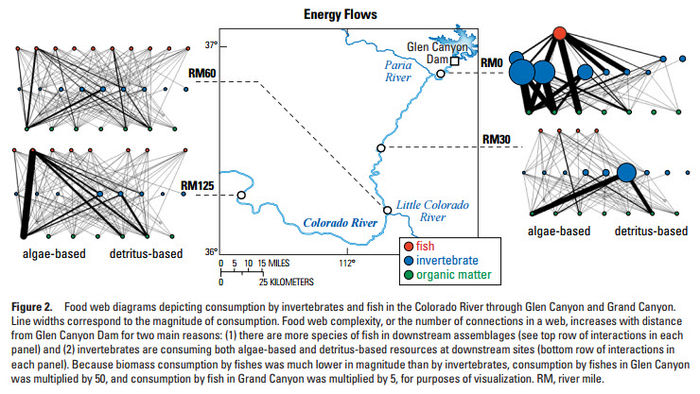Difference between revisions of "Foodwebs and Bioenergetics"
Cellsworth (Talk | contribs) |
Cellsworth (Talk | contribs) |
||
| (12 intermediate revisions by the same user not shown) | |||
| Line 17: | Line 17: | ||
</table> | </table> | ||
| − | + | [[File:Skinny fish1.jpg.jpg|center|500px]] | |
| − | + | A skinny rainbow trout in Lees Ferry 2012 | |
<!-- | <!-- | ||
| Line 24: | Line 24: | ||
|style="width:60%; font-size:120%;"| | |style="width:60%; font-size:120%;"| | ||
== '''Foodwebs and Bioenergetics below Glen Canyon Dam'''== | == '''Foodwebs and Bioenergetics below Glen Canyon Dam'''== | ||
| + | |||
| + | During periods of high fish abundance, food limitation can lead to extreme competition between [http://gcdamp.com/index.php?title=FISHERY '''rainbow trout'''] and [http://gcdamp.com/index.php?title=Humpback_Chub_Page '''humpback chub'''] for limited food resources resulting in large swings in in the trout population and skip spawning in the humpback chub population. These effects can be amplified by [http://gcdamp.com/index.php?title=TEMPERATURE increasing '''water temperature'''] if food production or availability don't correspondingly increase because warmer water increases fish metabolism requiring them to eat more food in order to maintain body condition. | ||
| + | |||
| + | [http://www.gcmrc.gov/about/foodbase/Cross%20et%20al._EM_2013.pdf '''Recent food web studies (2006-2009)'''] conducted in collaboration with University of Wyoming, Montana State University, Idaho State University, and the Cary Institute for Ecosystem Studies revealed that fish populations in the Colorado River downstream from Glen Canyon Dam appear to be limited by the availability of high-quality invertebrate prey. Midge and blackfly production is low and nonnative rainbow trout in Glen Canyon and native fishes in Grand Canyon consume virtually all of the midge and blackfly biomass that is produced annually. In Glen Canyon, the invertebrate assemblage is dominated by nonnative New Zealand mudsnails, the food web has a simple structure, and transfers of energy from the base of the web (algae) to the top of the web (rainbow trout) are inefficient. The food webs in Grand Canyon are more complex relative to Glen Canyon, because, on average, each species in the web is involved in more interactions and feeding connections. Based on theory and on studies from other ecosystems, the structure and organization of Grand Canyon food webs should make them more stable and less susceptible to large changes following perturbations of the flow regime relative to food webs in Glen Canyon. In support of this hypothesis, Grand Canyon food webs were much less affected by a 2008 controlled flood relative to the food web in Glen Canyon. [https://www.gcmrc.gov/research_areas/food_base/food_web_studies.aspx] | ||
|}<!-- | |}<!-- | ||
| Line 41: | Line 45: | ||
|style="color:#000;"| | |style="color:#000;"| | ||
| − | [ | + | [[File:2017AR LCRbiomass.jpg|center|500px]] [https://www.usbr.gov/uc/rm/amp/twg/mtgs/17jan26/AR19_Kennedy.pdf] |
| + | [[File:2017AR MidgeAbundance.jpg|center|500px]] [https://www.usbr.gov/uc/rm/amp/twg/mtgs/17jan26/AR19_Kennedy.pdf] | ||
| + | [[File:NO TroutAbundances2016.jpg|center|500px]] | ||
| + | [[File:HBCcondition2016.jpg|center|500px]] | ||
| + | |||
| + | |||
| + | ---- | ||
[[File:Foodbase fish production1.jpg|center|700px]] | [[File:Foodbase fish production1.jpg|center|700px]] | ||
[[File:Foodbase energy flows1.jpg|center|700px]] | [[File:Foodbase energy flows1.jpg|center|700px]] | ||
| Line 59: | Line 69: | ||
*[http://gcdamp.com/index.php?title=FOOD_BASE Aquatic Foodbase] | *[http://gcdamp.com/index.php?title=FOOD_BASE Aquatic Foodbase] | ||
*[http://www.gcmrc.gov/research_areas/food_base/food_base_default.aspx GCMRC Aquatic Food Base Lab] | *[http://www.gcmrc.gov/research_areas/food_base/food_base_default.aspx GCMRC Aquatic Food Base Lab] | ||
| + | *[https://www.gcmrc.gov/research_areas/food_base/food_web_studies.aspx Food web studies GCMRC Food web studies] | ||
|- | |- | ||
| Line 64: | Line 75: | ||
|- | |- | ||
|style="color:#000;"| | |style="color:#000;"| | ||
| + | |||
| + | '''2016''' | ||
| + | *[http://pubs.usgs.gov/fs/2016/3053/fs20163053.pdf Voichick et al. 2016. Water clarity of the Colorado River—Implications for food webs and fish communities: U.S. Geological Survey Fact Sheet 2016–3053, 4 p.] | ||
| + | *[http://www.usbr.gov/uc/rm/amp/twg/mtgs/16jan26/documents/AR16_Muehlbauer.pdf Food availability in the Little Colorado River over space and time] | ||
'''2014''' | '''2014''' | ||
| Line 72: | Line 87: | ||
*[http://www.gcmrc.gov/about/foodbase/Cross%20et%20al._EM_2013.pdf Cross et al. 2013: Food-web dynamics in a large river discontinuum] | *[http://www.gcmrc.gov/about/foodbase/Cross%20et%20al._EM_2013.pdf Cross et al. 2013: Food-web dynamics in a large river discontinuum] | ||
*[http://pubs.usgs.gov/fs/2013/3039/fs2013-3039.pdf USGS fact sheet: Native and nonnative fish populations of the Colorado River are food limited - Evidence from new food web analyses] | *[http://pubs.usgs.gov/fs/2013/3039/fs2013-3039.pdf USGS fact sheet: Native and nonnative fish populations of the Colorado River are food limited - Evidence from new food web analyses] | ||
| + | *[http://www.gcmrc.gov/about/foodbase/WellardKelley_et%20al.%202013.pdf Wellard-Kelly et al. 2013. Macroinvertebrate diets reflect tributary inputs and turbidity-driven changes in food availability in the Colorado River downstream of Glen Canyon Dam. Freshwater Science, 2013, 32(2):397–410] | ||
| + | |||
| + | '''2011''' | ||
| + | *[http://www.gcmrc.gov/about/foodbase/Donner_Thesis%202011.pdf Donner Thesis. 2011. Secondary production rates, consumption rates, and trophic basis of production of fishes in the Colorado River, Grand Canyon, AZ: An assessment of potential competition for food] | ||
| + | *[http://http://www.gcmrc.gov/about/foodbase/Zahn_Thesis_2011.pdf Zahn Thesis. 2011. Diet overlap and competition among native and non-native small-bodied fishes in the Colorado River, Arizona] | ||
| + | |||
| + | '''2010''' | ||
| + | *[http://www.gcmrc.gov/about/foodbase/Wellard%20Kelly_Thesis%202010.pdf Kelly Thesis 2010. Resource composition and macroinvertebrate resource consumption in the Colorado River below Glen Canyon Dam] | ||
| + | *[http://www.gcmrc.gov/about/foodbase/Hall%20et%20al.%20from%20sir2010-5135.pdf Hall et al. 2010. Aquatic production and carbon flow in the Colorado River Pages 105-112 in Proceedings of the Colorado River Basin Science and Resource Management Symposium, November 18–20, 2008, Scottsdale, Arizona] | ||
| + | *[http://www.gcmrc.gov/about/foodbase/Cross%20et%20al.%202010.pdf Cross et al. 2010. Invasion and production of New Zealand mud snails in the Colorado River, Glen Canyon] | ||
|- | |- | ||
Latest revision as of 17:16, 26 January 2018
|
A skinny rainbow trout in Lees Ferry 2012 |
Foodwebs and Bioenergetics below Glen Canyon DamDuring periods of high fish abundance, food limitation can lead to extreme competition between rainbow trout and humpback chub for limited food resources resulting in large swings in in the trout population and skip spawning in the humpback chub population. These effects can be amplified by increasing water temperature if food production or availability don't correspondingly increase because warmer water increases fish metabolism requiring them to eat more food in order to maintain body condition. Recent food web studies (2006-2009) conducted in collaboration with University of Wyoming, Montana State University, Idaho State University, and the Cary Institute for Ecosystem Studies revealed that fish populations in the Colorado River downstream from Glen Canyon Dam appear to be limited by the availability of high-quality invertebrate prey. Midge and blackfly production is low and nonnative rainbow trout in Glen Canyon and native fishes in Grand Canyon consume virtually all of the midge and blackfly biomass that is produced annually. In Glen Canyon, the invertebrate assemblage is dominated by nonnative New Zealand mudsnails, the food web has a simple structure, and transfers of energy from the base of the web (algae) to the top of the web (rainbow trout) are inefficient. The food webs in Grand Canyon are more complex relative to Glen Canyon, because, on average, each species in the web is involved in more interactions and feeding connections. Based on theory and on studies from other ecosystems, the structure and organization of Grand Canyon food webs should make them more stable and less susceptible to large changes following perturbations of the flow regime relative to food webs in Glen Canyon. In support of this hypothesis, Grand Canyon food webs were much less affected by a 2008 controlled flood relative to the food web in Glen Canyon. [1] |
| -- |
-- |
-- |
|---|
